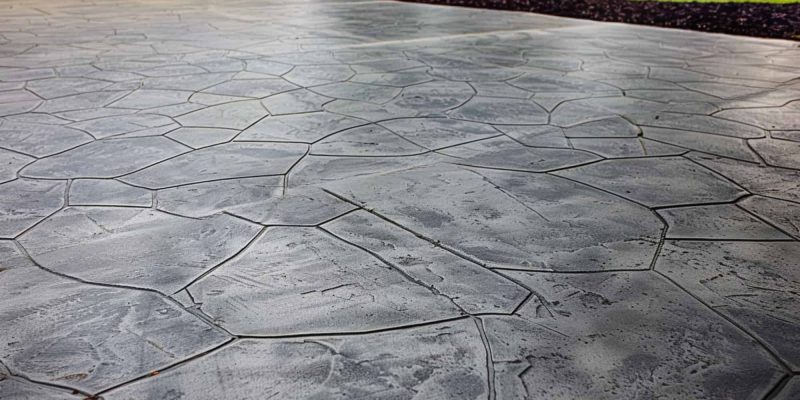Welcome to the world of stamped concrete—a smart choice for homeowners looking to jazz up their outdoor spaces without breaking the bank. Wherever you are, this guide will walk you through how to create beautiful, durable surfaces that mimic more expensive materials like stone, brick, or wood.
The Benefits of Stamped Concrete
Aesthetic Versatility: One of the coolest things about stamped concrete is how it can look like almost anything. Want a patio that looks like flagstone but don’t want to pay flagstone prices? Stamped concrete is your friend. You can choose from a wide range of colors and patterns to match your home’s style.
Durability and Maintenance: Stamped concrete isn’t just pretty; it’s tough. It can handle Rockford’s weather, from hot summers to chilly winters, and it doesn’t need much upkeep. Just a simple wash and resealing every few years keep it looking fresh.
Cost-Effectiveness: Compared to natural stone or pavers, stamped concrete is a wallet-friendly option. It offers the high-end look you desire without the high-end cost, making it a great investment for your home.
…stamped concrete is a wallet-friendly option for your home.
Uses of Stamped Concrete
Patios and Walkways: Transform your backyard into a stylish retreat. Stamped concrete patios and walkways offer a seamless look that complements your outdoor living space.
Driveways: Boost your home’s curb appeal with a stamped concrete driveway. It’s not only beautiful but also durable enough to withstand the wear and tear of daily use.
Pool Decks: Create a safe and stunning area around your pool. Stamped concrete provides a slip-resistant surface that’s perfect for wet feet, plus it’s cool to the touch under the hot sun.
Essential Tools for Stamping Concrete
Before diving into your project, make sure you have the right tools on hand. Here’s what you’ll need:
Preparation Tools
Shovels, rakes, and tampers help prepare the ground. You’ll need a firm, level base to start.
Concrete Mixing Tools
A concrete mixer is essential for achieving the right consistency. You can rent one if you don’t own it.
Stamping Tools
These are the patterns that press into the concrete to create your desired look. They come in various shapes and designs.
Coloring Tools
Concrete color hardeners and release agents add hue and shading to your concrete, making it look like natural stone or wood.
Sealing Tools
Finally, a good-quality sealant and a sprayer or roller are needed to protect your finished project.
Let’s take a short pause here. In the next section, we’ll dive into the step-by-step process of creating stamped concrete, ensuring you have all the details you need to get started on your project.
Step-by-Step to Ensure Success
Creating a beautiful stamped concrete surface is a rewarding project that adds value and appeal to your home. Here’s a more detailed guide to ensure success:
Step 1: Planning and Design
Before you start, plan the area where you want to install stamped concrete. Consider its use, the existing landscape, and how the pattern and color you choose will complement your home. Measure the area to calculate how much material you’ll need.
Step 2: Preparation of the Site
The first physical step is to prepare the site. This involves removing any existing surface material, like grass or paving, and ensuring the ground is level.
Compact the soil to provide a stable base, and then add a sub-base layer of gravel. The gravel should also be compacted and leveled to ensure proper drainage and support.
Step 3: Creating Forms
Once your base is ready, you’ll need to create forms around the perimeter of your project area. These forms will hold the concrete in place as it dries and should be made from sturdy materials like wood or metal. Ensure they are securely staked into the ground and are level to achieve an even surface.
Step 4: Mixing and Pouring Concrete
Mix the concrete according to the manufacturer’s instructions, aiming for a consistency that is easy to work with but not too runny. Pour the concrete into the forms, spreading it evenly with a shovel or rake.
Use a screed board to level the concrete, followed by a float to smooth out any air bubbles and ensure an even surface.
TIP
Make sure to work quickly but carefully in this step. It’s important to keep in mind that concrete sets faster than we may anticipate!
Step 5: Applying Color and Texture
Before the concrete starts to harden, apply a color hardener by throwing it onto the surface and spreading it evenly with a float. This not only colors the concrete but also strengthens the surface. Next, apply a release agent, which will prevent the stamps from sticking to the concrete.
Then, press your chosen stamps into the concrete, starting from one end and working your way to the other, making sure to overlap the edges of each stamp to avoid any lines.
Step 6: Detailing and Cutting Joints
Once the concrete is stamped, you can add details with hand tools to enhance the look.
Cutting contraction joints in the concrete helps control where it cracks as it contracts during drying. These joints can be incorporated into the design to make them less noticeable.
Step 7: Curing and Sealing
Allow the concrete to cure for at least 24-48 hours before walking on it. After curing, wash off the residual release agent, and let the concrete dry completely.
Finally, apply a sealant to protect the surface from stains, enhance the color, and give it a glossy finish. The sealant also extends the life of your stamped concrete.
Step 8: Maintenance
Regular maintenance involves cleaning the surface with soap and water and resealing it every 2-3 years to maintain its appearance and durability.
You can successfully create and maintain a beautiful stamped concrete surface that enhances your home’s outdoor space by following these steps.
Mistakes to Avoid and When to Call a Pro
Timing Errors: One common mistake is stamping too early or too late. If the concrete is too wet, your stamps will sink too deep. If it’s too dry, they won’t make a clear impression. Watch for the concrete to start setting but still be pliable.
Improper Tool Use: Using the wrong tools or techniques can ruin your project. Ensure you’re using stamping tools correctly and applying color hardeners evenly.
Overworking the Surface: Too much fussing can weaken the surface. Work efficiently and avoid repeated stamping in the same area.
Professional Help: If your project is large or complex, consider hiring a pro. Professionals can manage bigger areas, ensure an even application, and tackle any unexpected challenges.
Common Issues and Questions
Why is my stamped concrete cracking?
Cracking can occur due to several reasons, including improper base preparation, inadequate concrete mix, or lack of control joints. To prevent cracks, ensure the base is compact and level, follow the concrete mix instructions carefully, and cut control joints at the recommended spacing.
How do I maintain my stamped concrete surface?
Maintain your stamped concrete by regularly sweeping and washing it to remove dirt and debris. Avoid using harsh chemicals or abrasive tools that can damage the surface. Reseal the concrete every 2-3 years to protect it from the elements and keep it looking new.
Can stamped concrete be repaired if it’s damaged?
Yes, small cracks or chips can be repaired with a concrete patching compound that matches the color of your stamped concrete. For larger areas of damage or extensive cracking, it may be necessary to replace sections of the concrete or consult a professional for repair options.
How long does stamped concrete last?
When properly installed and maintained, stamped concrete can last for decades. Its lifespan can be extended with regular cleaning, avoiding harsh chemicals, and resealing every few years to protect against weathering and wear.
Is stamped concrete slippery when wet?
Stamped concrete can be slippery, especially when sealed with a high-gloss sealant. To reduce slipperiness, add a non-slip additive to the sealant or choose a sealant with built-in slip resistance. Textured stamps that create a rougher surface can also help improve traction.
Conclusion
Stamped concrete is a fantastic way to add beauty and value to your home. With a bit of planning, the right tools, and some elbow grease, you can create a stunning outdoor space that lasts. Remember, the key to success is in the preparation and not rushing through the steps. And if you’re ever in doubt, don’t hesitate to call in a professional. Happy stamping!

